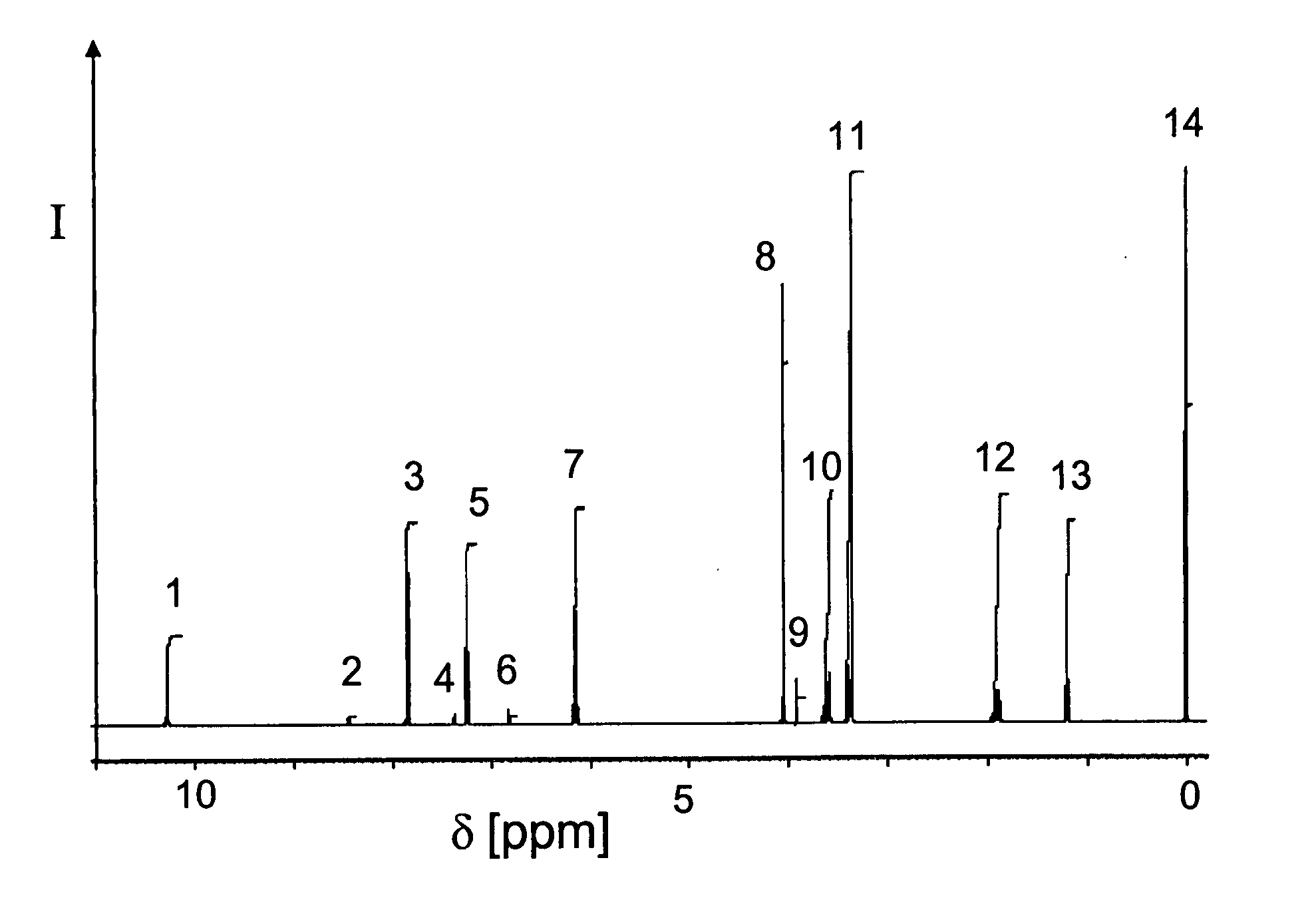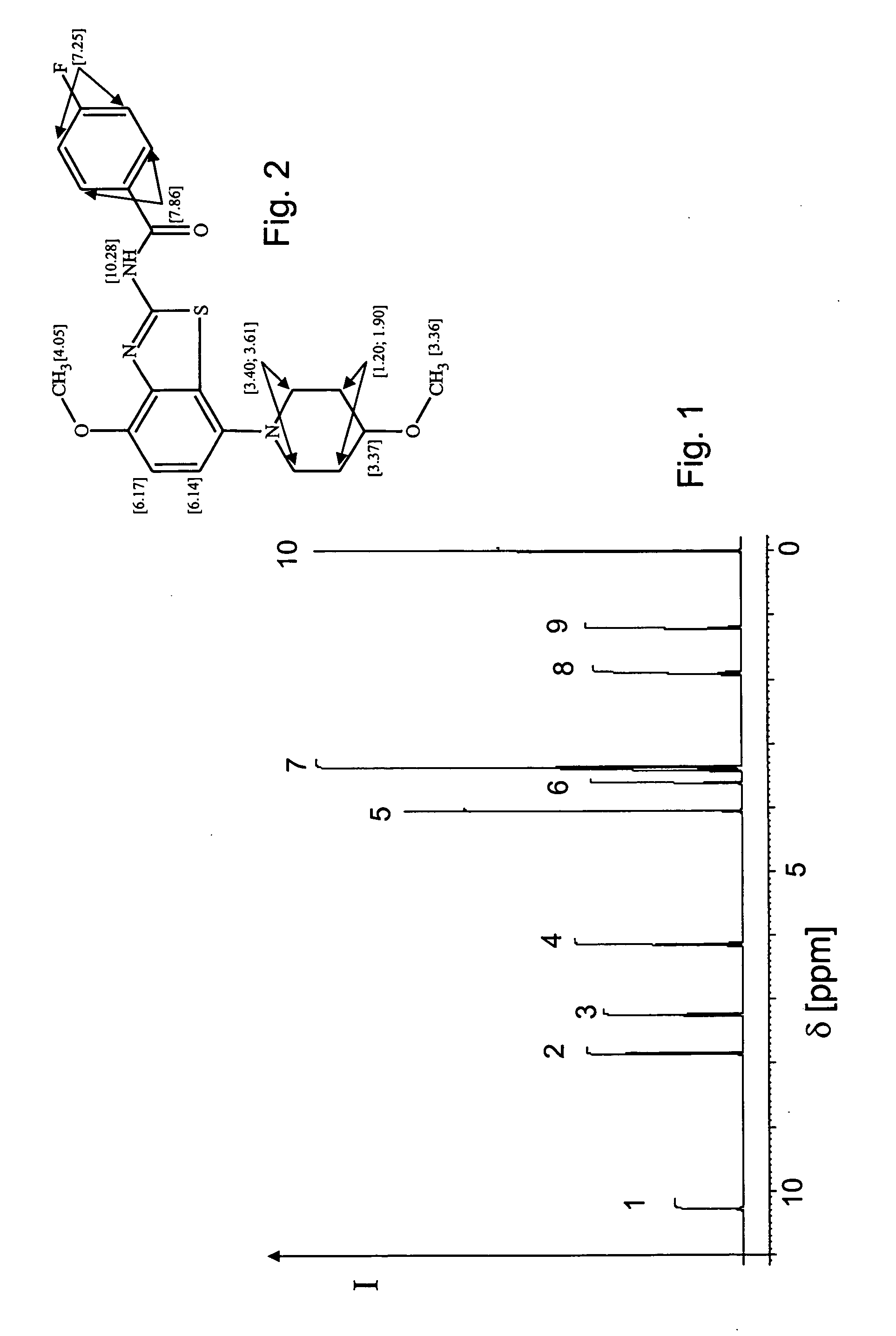Method for estimating the number of nuclei of a preselected isotope in a molecular species from and NMR spectrum
a technology of molecular species and nuclei, applied in the field of methods for estimating the number of nuclei of preselected isotopes in molecular species from and nmr spectrum, can solve the problems of overlapping nmr signal peaks, inaccuracy in the determination of integrals, and deviation of theoretical expectations of the nmr spectrum obtained in practi
- Summary
- Abstract
- Description
- Claims
- Application Information
AI Technical Summary
Benefits of technology
Problems solved by technology
Method used
Image
Examples
example 1
[0076] This example illustrates the application to an essentially pure sample of a species with unknown number of nuclei. FIG. 1 shows a 1H-NMR spectrum of a sample containing C21H22FN3O3S (see FIG. 2), henceforth denoted as “molecular species A”, and an admixture of tetramethyl silane (TMS), a well-known calibration substance for NMR spectroscopy. While it is known that molecular species A contains 22 protons, this information will not be used in the forthcoming procedure. The spectrum contains a plurality of signal peaks having chemical shifts δ in the range from about 0 to 11 ppm. While all these peaks have some multiplet structure, it is readily seen that the overall spectrum is made up of ten distinct signal peaks. In the present case, only signal peaks between 1 and 11 ppm are included for further analysis and define the set of included signal peaks P with members {P1, P2, . . . , P9}. The signal at 0 ppm is known to originate from TMS and will be used in Example 3 for calibra...
example 2
[0087] This example illustrates the application to a contaminated sample containing a predominant molecular species A but also a substantial contribution of an impurity. FIG. 4 shows the 1H-NMR spectrum of a second sample, containing molecular species A, the calibration compound TMS and an admixture of 10% of C13H14CIN3O3, henceforth denoted as “molecular species B”. For the purpose of this example, molecular species B is considered to be an unknown impurity in the sample.
[0088] Again, only signal peaks in the range of chemical shifts from 1 to 11 ppm are taken to build the set of included signal peaks, which is ordered according to peak position, thus forming the set Π of ordered signal peaks. After integration of each ordered signal peak the set of ordered integrals S={S1, S2, . . . , S13}, listed in Table 5 is obtained. In contrast to the Example 1, there are now 13 ordered integrals instead of 9; peak no. 14 originates from TMS and does not belong to the set of included signal ...
example 3
[0091] In this example, reference is made to the results of Example 1, which are used to carry out a quantitative determination of molecular species A in the sample at issue. Such determination relies on the fact that the calibration compound TMS contains 12 protons per molecule. Moreover, the method exploits the total or partial numbers of nuclei determined for species A and the relative magnitudes of NMR signal integrals found for A and TMS. The integrals mentioned below are all expressed in arbitrary units which, however, are the same arbitrary units for all the integrals from a given NMR spectrum.
[0092] A calibration integral YTMS is obtained by integrating peak no. 14, which originates from TMS, and dividing by the number of protons, which is known to be 12. In the present case, this leads to a calibration integral YTMS=15.23 / 12=1.27.
[0093] Moreover, a quantitation set is defined which consists of at least one of the ordered signal peaks of species A. A normalized sample inte...
PUM
| Property | Measurement | Unit |
|---|---|---|
| chemical shift | aaaaa | aaaaa |
| chemical shifts δ | aaaaa | aaaaa |
| chemical shifts | aaaaa | aaaaa |
Abstract
Description
Claims
Application Information
 Login to View More
Login to View More - R&D
- Intellectual Property
- Life Sciences
- Materials
- Tech Scout
- Unparalleled Data Quality
- Higher Quality Content
- 60% Fewer Hallucinations
Browse by: Latest US Patents, China's latest patents, Technical Efficacy Thesaurus, Application Domain, Technology Topic, Popular Technical Reports.
© 2025 PatSnap. All rights reserved.Legal|Privacy policy|Modern Slavery Act Transparency Statement|Sitemap|About US| Contact US: help@patsnap.com



